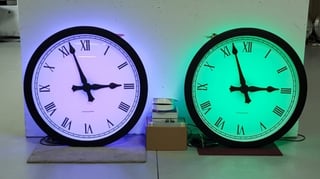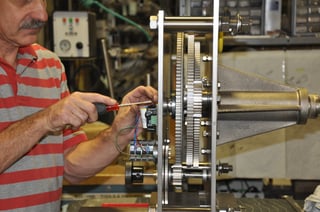Have you remembered to “spring forward" yet? If you were up very early on Sunday morning, you might’ve noticed the clock on your phone suddenly jumped an hour into the future—don’t forget to reset your watch, too! This leap marked the beginning of Daylight Saving Time, the period from the second Sunday in March to the first Sunday in November when clocks are set one hour ahead of Standard Time. While the extra hour of sleep gained during the return in the fall to Standard Time is quite popular amongst night owls and college students, this biannual time adjustment is also responsible for plenty of headaches. One of the complications it creates is also an interesting engineering problem—how do you make sure everyone is “on time”?
Time for Technology
 How does your computer or phone know to skip (or add) an hour? What about all of those giant clocks on the sides of tall buildings—is someone climbing up to move their hands twice a year? We caught up with a few engineers from the Electric Time Company, the clock manufacturer featured in the context-setting video for our Engineering Everywhere unit It’s About Time: Engineering Timekeepers, to ask them about the modern technology behind the face of this coordinated shift.
How does your computer or phone know to skip (or add) an hour? What about all of those giant clocks on the sides of tall buildings—is someone climbing up to move their hands twice a year? We caught up with a few engineers from the Electric Time Company, the clock manufacturer featured in the context-setting video for our Engineering Everywhere unit It’s About Time: Engineering Timekeepers, to ask them about the modern technology behind the face of this coordinated shift.
We learned that there’s a modern technology you might recognize from your car’s navigation system keeping up with all of these different times: a GPS receiver! The hands of each clock are coordinated to within 1 x 10E6 seconds of UTC (Coordinated Universal Time) by an internal electronic controller that receives UTC time from an attached GPS receiver. Each of the GPS satellites that communicate with this receiver has multiple extremely accurate cesium (or rubidium) atomic clocks onboard. Your phone is also using similar GPS-dependent technology to show you the correct time!
 But UTC time is not the local time, and the clock controller must adjust the hour to correctly offset from UTC. For example, the time in Boston is offset –5 hours from UTC during Standard Time and –4 hours during Daylight Saving Time. Electric Time’s clocks are located on every continent and must maintain accurate time in every time zone. Some zones observe Daylight Saving Time, some don’t, and some only mark a half hour difference from their neighboring zone. Thus, their engineers must make sure that each clock has the correct programming in its electronic controller to calculate the right offset for its location.
But UTC time is not the local time, and the clock controller must adjust the hour to correctly offset from UTC. For example, the time in Boston is offset –5 hours from UTC during Standard Time and –4 hours during Daylight Saving Time. Electric Time’s clocks are located on every continent and must maintain accurate time in every time zone. Some zones observe Daylight Saving Time, some don’t, and some only mark a half hour difference from their neighboring zone. Thus, their engineers must make sure that each clock has the correct programming in its electronic controller to calculate the right offset for its location.
If you’re exploring timekeeping and mechanical engineering with It’s About Time, encourage your kids to think more deeply about time by introducing them to the fascinating technology that makes Daylight Saving Time “tick.” You could also share this story about the world’s most accurate clock to inspire their design while they’re engineering their own timekeeping devices.
A Wrinkle in Daylight Saving Time
 One of the engineering habits of mind we hope EiE learners develop is the ability to assess the implications of their solutions, and there are certainly some ethical implications to consider concerning Daylight Saving Time. While the science is still out on whether or not sleepier drivers cause more accidents the day after the time shift, at least one study has found that this loss of an hour can increase the amount of cyberloafing—time spent on Facebook or watching the latest cat video—employees engage in at work. What other Daylight Saving Time-related consequences can your students think of? Try asking your class of timer engineers if they think Daylight Saving Time is a technology, and what problem it was designed to solve. Could they think of any ways to improve it? Are there other technologies that help us enjoy summer sun or deal with dark winter mornings?
One of the engineering habits of mind we hope EiE learners develop is the ability to assess the implications of their solutions, and there are certainly some ethical implications to consider concerning Daylight Saving Time. While the science is still out on whether or not sleepier drivers cause more accidents the day after the time shift, at least one study has found that this loss of an hour can increase the amount of cyberloafing—time spent on Facebook or watching the latest cat video—employees engage in at work. What other Daylight Saving Time-related consequences can your students think of? Try asking your class of timer engineers if they think Daylight Saving Time is a technology, and what problem it was designed to solve. Could they think of any ways to improve it? Are there other technologies that help us enjoy summer sun or deal with dark winter mornings?








